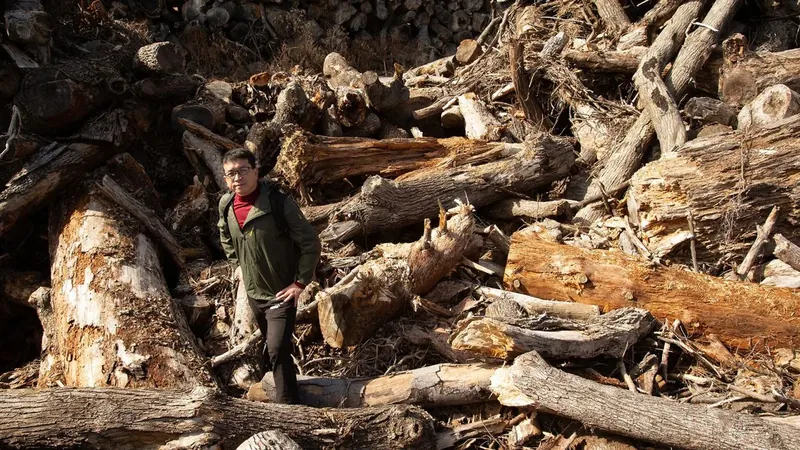
4,000-Year-Old Driftwood Discovery: A Game Changer in the Fight Against Climate Change!
2024-10-08
Author: Ying
A Game Changer in Climate Change
A fascinating discovery of a remarkably preserved log, buried nearly 4,000 years ago, could unlock groundbreaking methods for combating climate change. This ancient piece of driftwood offers compelling evidence for an innovative strategy: burying dead trees in what scientists call "wood vaults" to effectively sequester carbon and reduce harmful greenhouse gas emissions.
Groundbreaking Study
In a groundbreaking study published on September 26 in the prestigious journal Science, researchers unveiled their findings on a 3,775-year-old log located in Saint-Pie, Quebec, Canada. This remarkable stump was unearthed during a 2013 excavation aimed at identifying suitable locations for creating wood vaults, which involve entombing woody biomass beneath layers of clay soil to prevent carbon from re-entering the atmosphere.
Biological Carbon Sequestration
Wood vaulting operates under the powerful concept of biological carbon sequestration — harnessing the natural ability of organic matter to capture carbon. Lead author Ning Zeng, a climate scientist from the University of Maryland and a driving force behind the commercialization of this technology, made initial claims about burying wood for carbon capture in a 2008 study.
A Vital Data Point
"This log serves as a vital data point," Zeng stated. "It demonstrates that if you bury wood under these specific conditions, it will effectively sequester carbon. This is immediately implementable and a crucial step towards addressing climate issues."
Discovery of the Log
The ancient log belonged to an Eastern red cedar (Juniperus virginiana) and was found buried under 6.5 feet (2 meters) of dense blue clay close to a creek bed. According to Zeng, it likely became buried during a flooding event, becoming driftwood that would have been transported there by natural forces.
Role of Clay Sediment
The unique clay sediment played an essential role in preserving the wood. It created an anaerobic environment, restricting the growth of microorganisms that would typically contribute to decay, as oxygen levels are too low for most organisms. The log's lignin and holocellulose — the primary components of wood known for their decay resistance — remained largely intact.
Carbon Retention
Infrared spectroscopy and scanning electron microscopy revealed that the log had retained most of the carbon it absorbed during its lifetime. Carbon dating confirmed that this ancient log had been buried for nearly four millennia, containing about 5% less carbon than a contemporary log from the same tree species. However, this minor difference is attributed to varying environmental conditions.
Advocating for Wood Vaults
The study provides a strong argument for expanding the practice of wood vaulting, as the authors highlight that while living plants can capture substantial amounts of atmospheric carbon — removing billions of tons of carbon dioxide annually — much of it is quickly returned to the atmosphere through decay or combustion. By burying large numbers of trees, scientists believe we could potentially offset nearly one-third of our yearly fossil fuel emissions.
Potential for Urban Waste Wood
Another exciting aspect is the idea that waste wood from urban trimming or managed forests could be redirected to these wood vaults with relative simplicity and cost-effectiveness. Zeng also points out that clay soils are plentiful, and sites for wood vaulting could later be transformed into agricultural areas or solar farms once the wood is buried.
Conclusion
In conclusion, the discovery of this ancient driftwood is more than just an archaeological find; it represents a significant step towards developing sustainable solutions for our climate crisis. As scientists and environmentalists work together to implement wood vaulting on a larger scale, the potential benefits could be monumental in the fight against climate change, making it an initiative worth watching in the coming years!


 Brasil (PT)
Brasil (PT)
 Canada (EN)
Canada (EN)
 Chile (ES)
Chile (ES)
 España (ES)
España (ES)
 France (FR)
France (FR)
 Hong Kong (EN)
Hong Kong (EN)
 Italia (IT)
Italia (IT)
 日本 (JA)
日本 (JA)
 Magyarország (HU)
Magyarország (HU)
 Norge (NO)
Norge (NO)
 Polska (PL)
Polska (PL)
 Schweiz (DE)
Schweiz (DE)
 Singapore (EN)
Singapore (EN)
 Sverige (SV)
Sverige (SV)
 Suomi (FI)
Suomi (FI)
 Türkiye (TR)
Türkiye (TR)